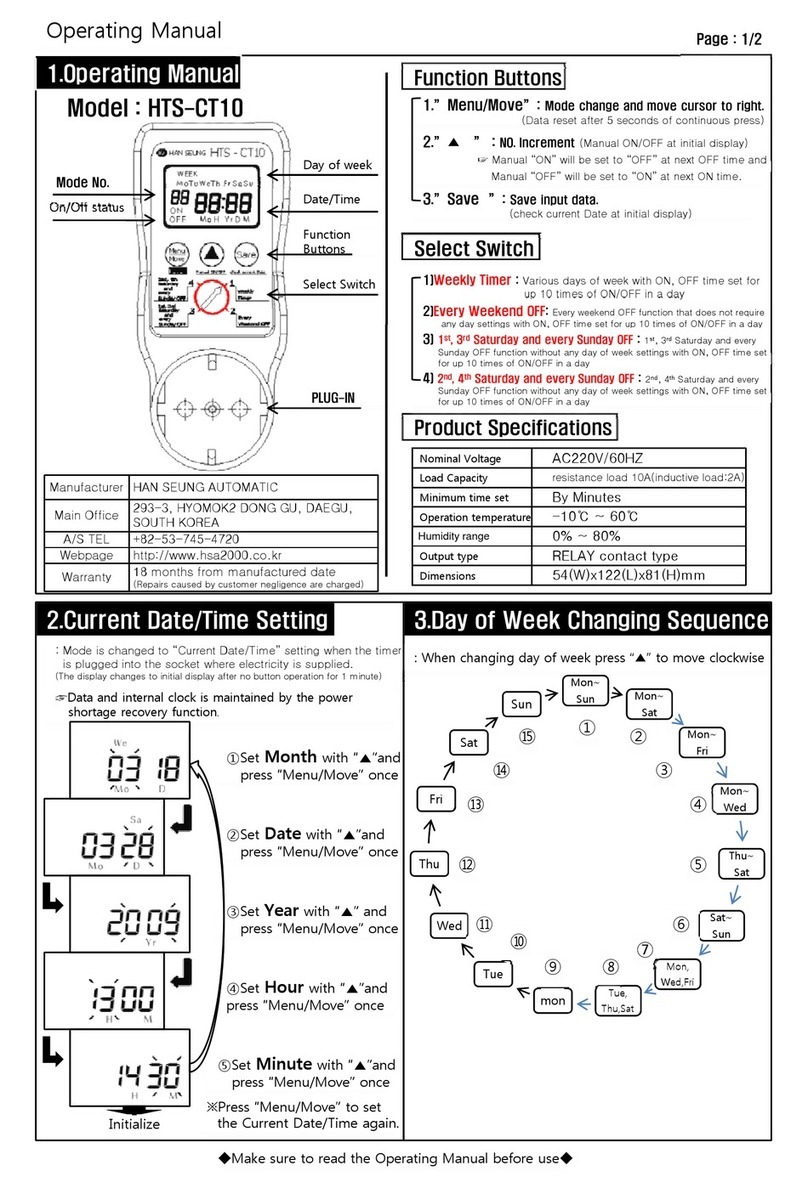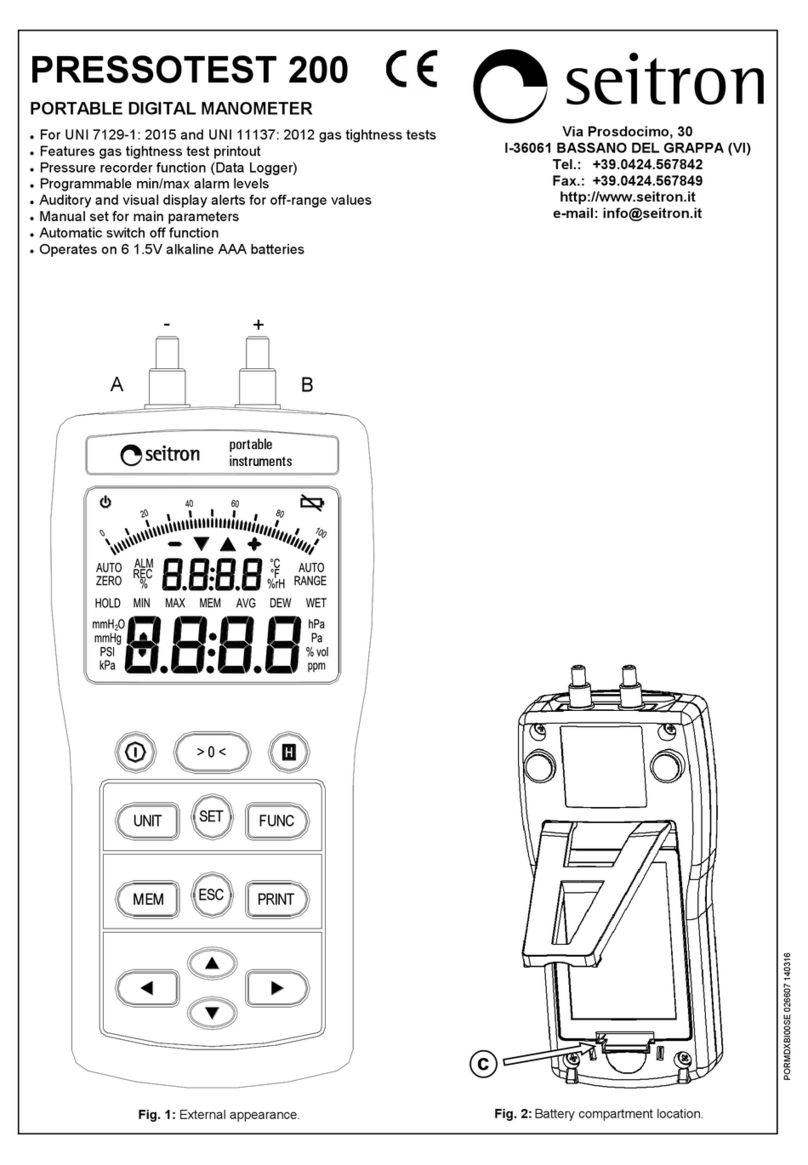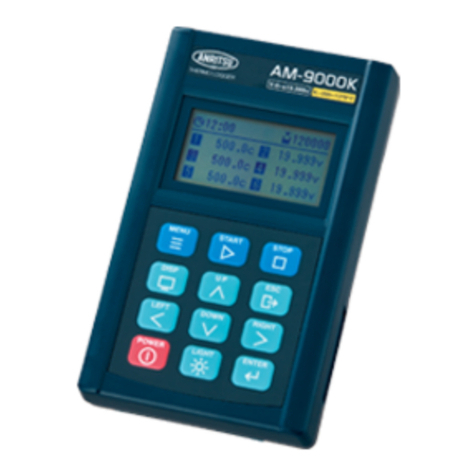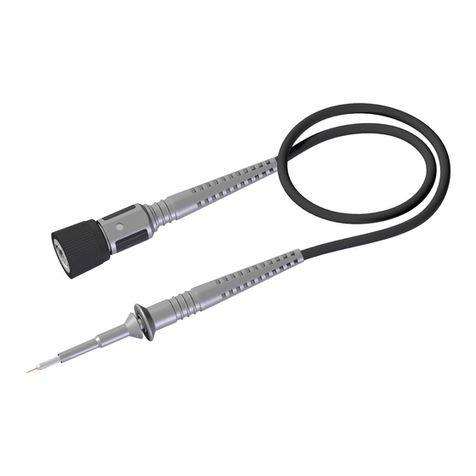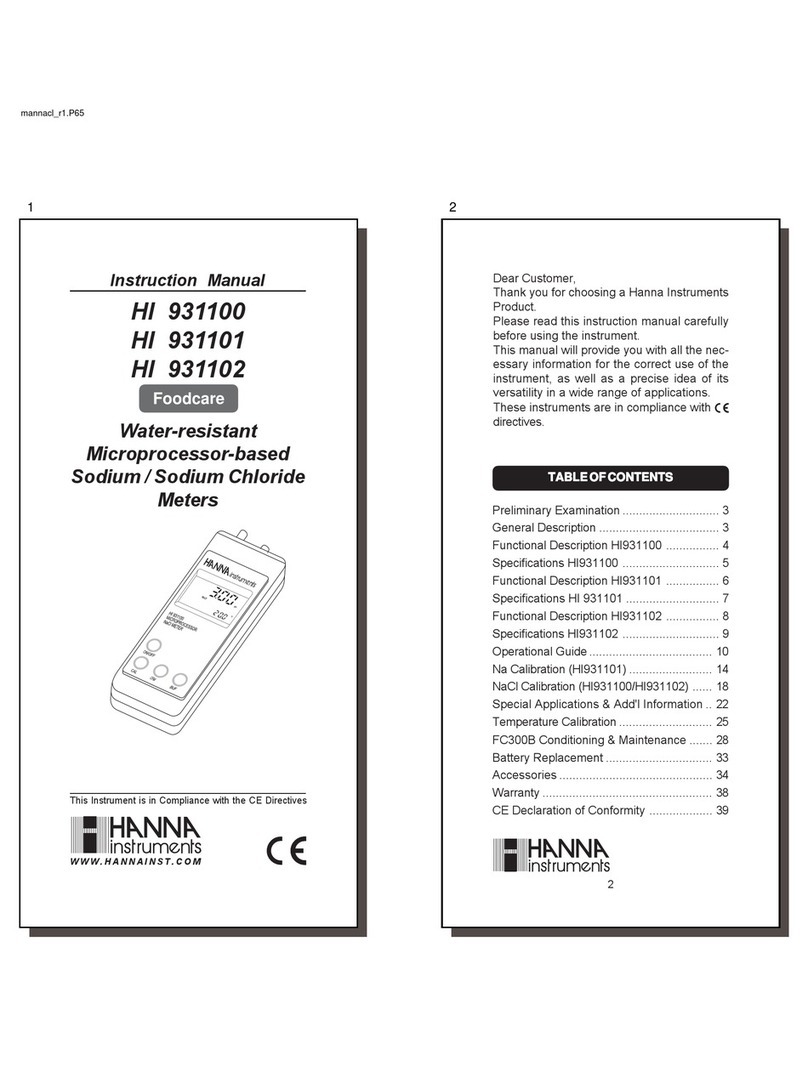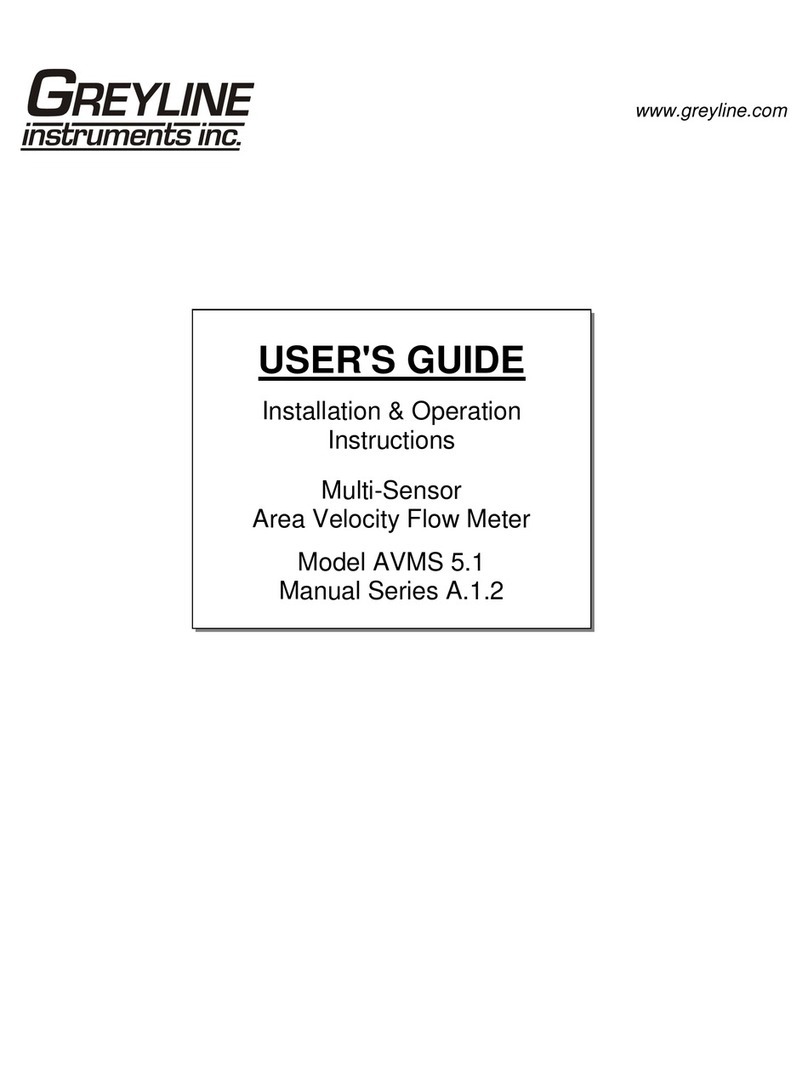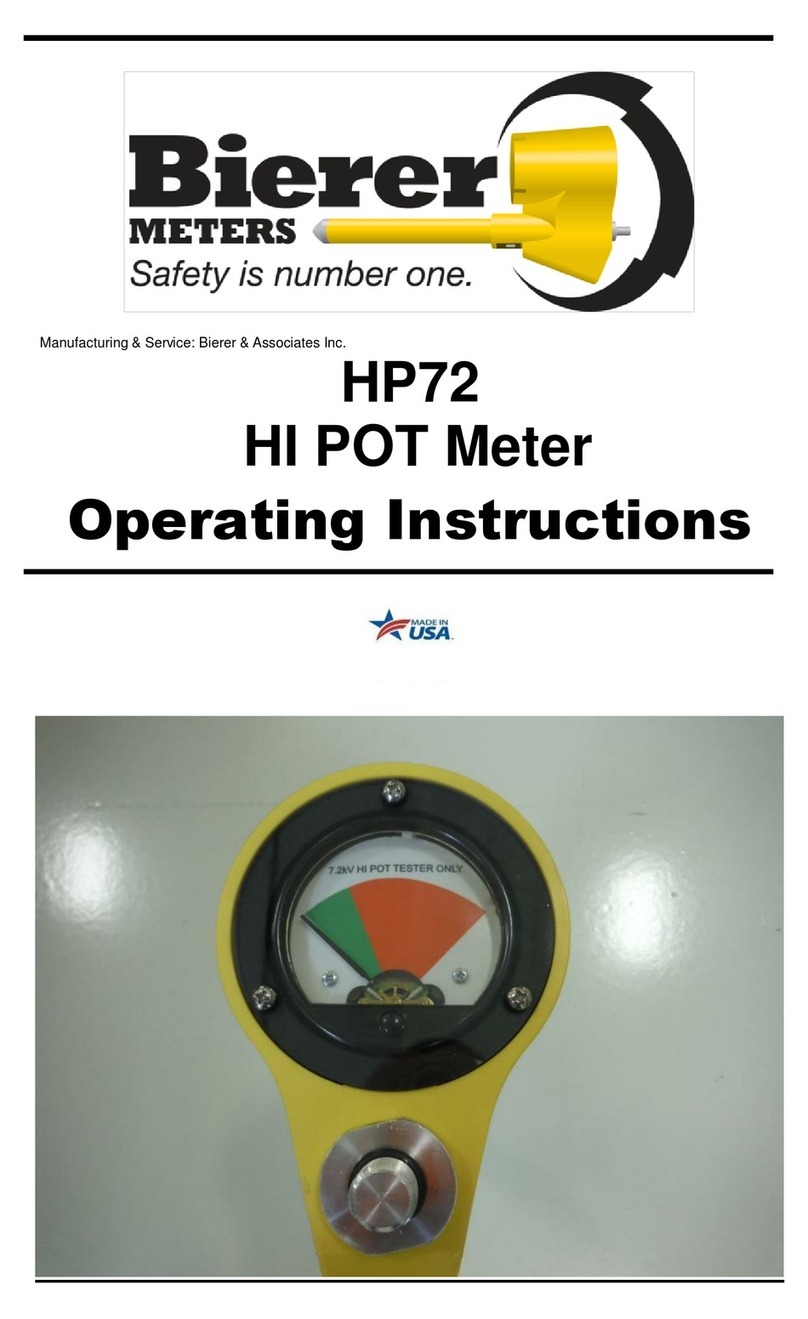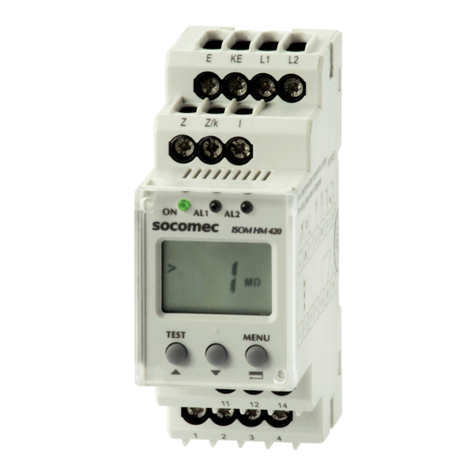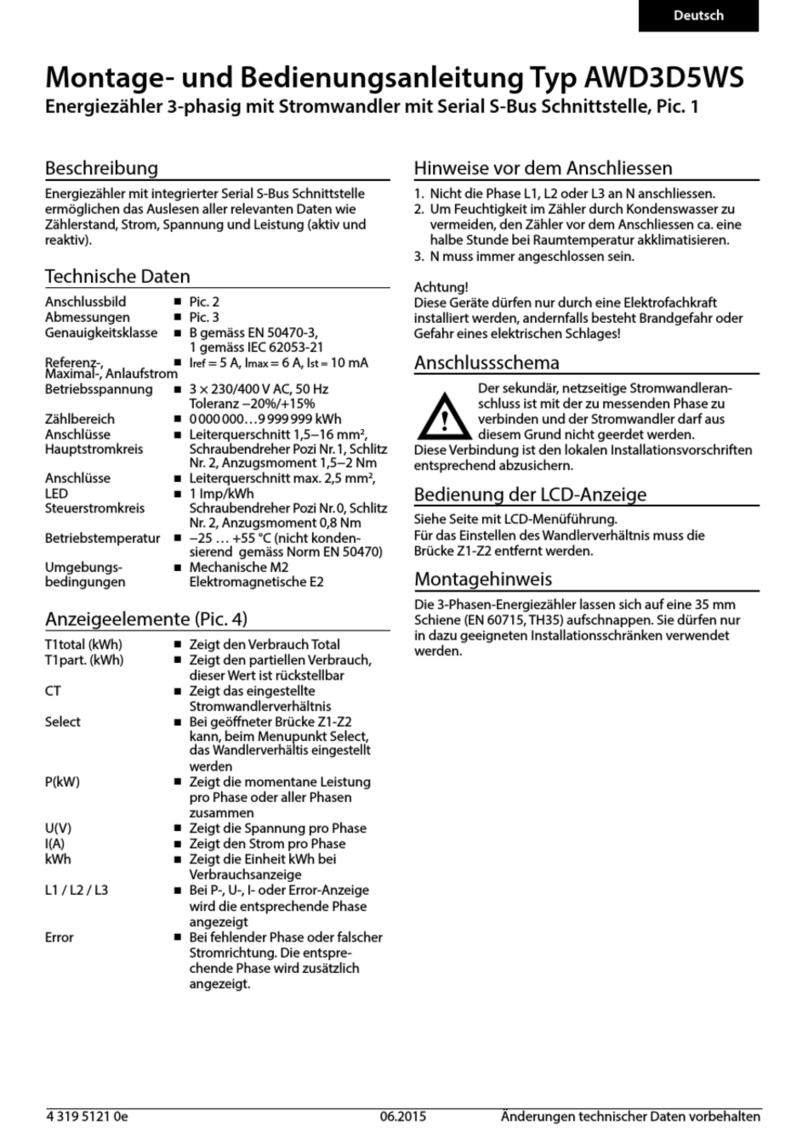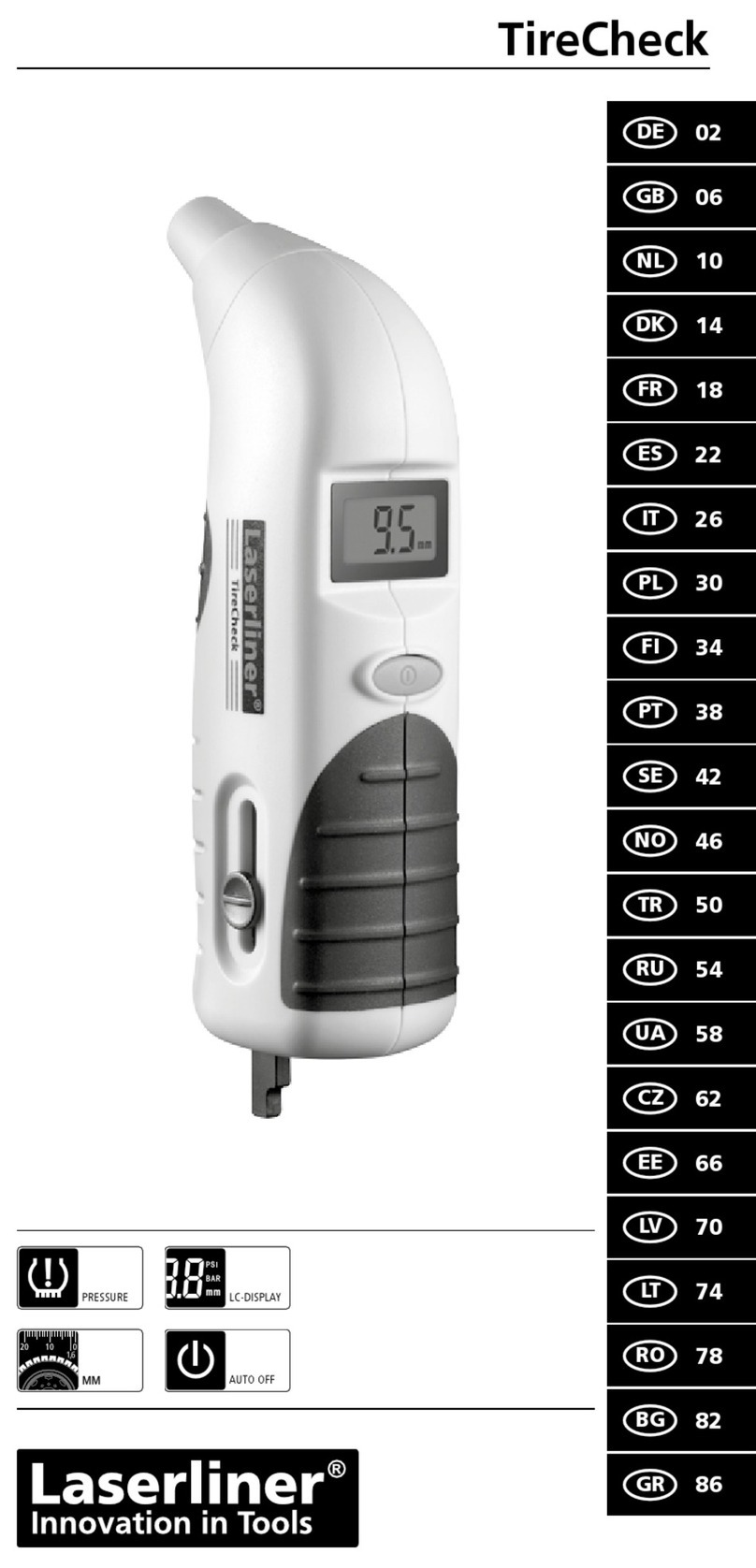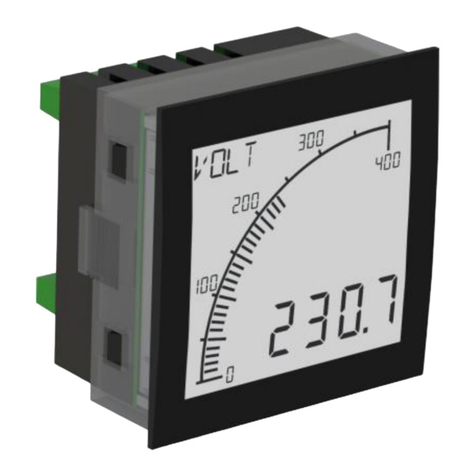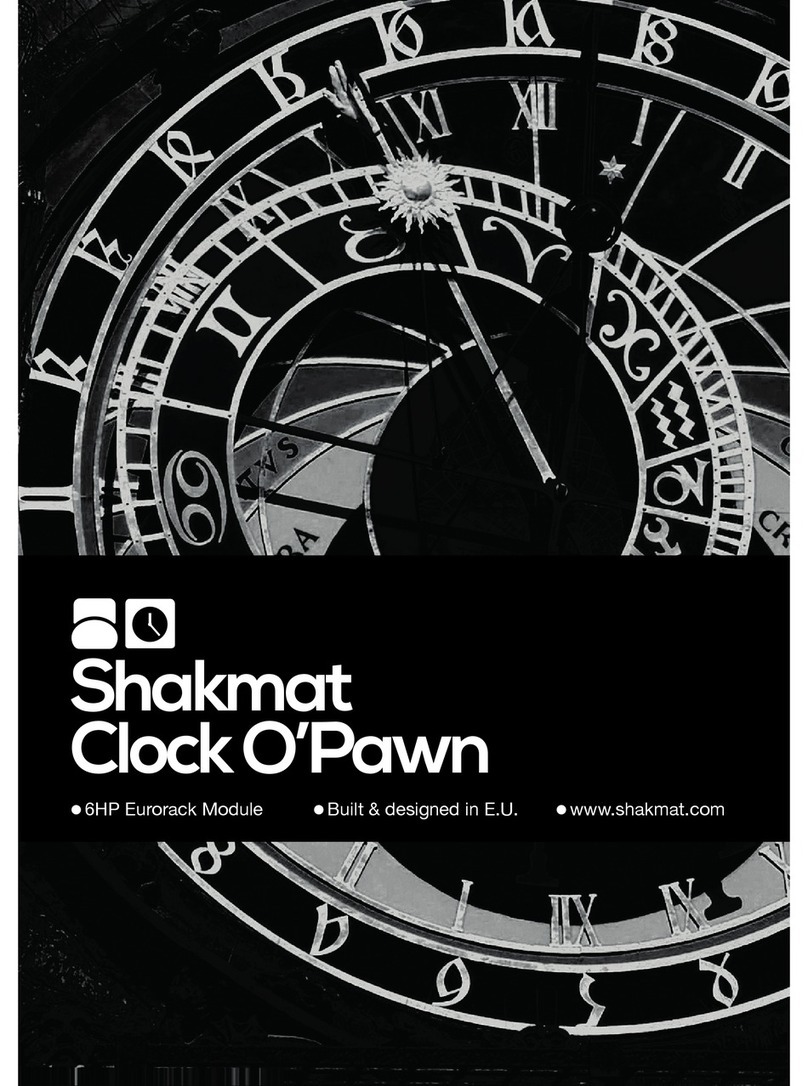Rockford Systems Stop-Time Measuring Device User manual

IMPORTANT: PLEASE REVIEW THIS ENTIRE
PUBLICATION BEFORE OPERATING OR MAINTAINING
THE STOP-TIME MEASURING DEVICE.
INSTRUCTION MANUAL FOR
STM(STOP-TIME Measuring) Device
5795 Logistics Parkway • Rockford, Illinois 61109 • Toll-Free 1-800-922-7533 • Phone (815) 874-7891
Manual No. KSL-220

Rockford Systems, LLC
1-800-922-7533 (U.S.A. only)
2
SECTION 1—TABLE OF CONTENT
Stop-Time Measurement Device
SECTION 1—IN GENERAL ...............................................................................................................................3 - 10
SECTION 2—INTRODUCTION ........................................................................................................................11 - 13
SECTION 3—OPERATING INSTRUCTIONS.....................................................................................................14 - 15
SECTION 4—SOFTWARE FLOWCHART ................................ ................................................................................16
SECTION 5—PROGRAMMING .......................................................................................................................17 - 26
General Programming Information............................................... .............................................................17 - 19
MM STOP-TIME MEASURING............................................................................... ........................... ................20
MM POWER DOWN SWITCH OFF......................................................................... ............................ ...............20
MM TEST FUNCTION AND SERVICE.................................................................................................... .............21
MM MEASURING DATA MANAGEMENT................................................................ ............................. ..............22
MM PRINT MANAGER................................................................................................................... ..................23
MM PARAMETER 1 BASIC SETTINGS.................................................................... ............................. .............24
MM PARAMETER 2 SAFETY DISTANCE................................................................................................ ............25
MM PARAMETER 3 MEASURING........................................................................... ............................ ..............26
SECTION 6—FAULT MESSAGES .............................. ............................................................................................27
SECTION 7—REPLACEMENT PARTS................................ ....................................................................................27
SECTION 8—RETURN MATERIALS AUTHORIZATION & ORDER FORM.................................... ............................28
Copyright © 2019 Rockford Systems, LLC. All rights reserved. Not to be reproduced in whole or in part without written permission. Litho in U.S.A.

Rockford Systems, LLC
1-800-922-7533 (U.S.A. only) 3
SECTION 1—IN GENERAL
Stop-Time Measurement Device
Efficient and safe machine operation depends on the development, implementation and enforcement of a safety program.
This program requires, among other things, the proper selection of point-of-operation guards and safety devices for each
particular job or operation and a thorough safety training program for all machine personnel. This program should include
instruction on the proper operation of the machine, instruction on the point-of-operation guards and safety devices on the
machine, and a regularly scheduled inspection and maintenance program.
Rules and procedures covering each aspect of your safety program should be developed and published both in an operator’s
safety manual, as well as in prominent places throughout the plant and on each machine. Some rules or instructions which
must be conveyed to your personnel and incorporated into your program include:
Danger is used to indicate the presence of a hazard which WILL cause
SEVERE personal injury if the warning is ignored.
THIS SAFETY ALERT SYMBOL IDENTIFIES IMPORTANT SAFETY
MESSAGES IN THIS MANUAL. WHEN YOU SEE THIS SYMBOL , BE
ALERT TO THE POSSIBILITY OF PERSONAL INJURY, AND CAREFULLY
READ THE MESSAGE THAT FOLLOWS.
A company’s safety program must involve everyone in the company, from top management to operators,since only as a
group can any operational problems be identified and resolved. It is everyone’s responsibility to implement and communicate
the information and material contained in catalogs and instruction manuals to all persons involved in machine operation.
If a language barrier or insufficient education would prevent a person from reading and understanding various literature
available, it should be translated, read or interpreted to the person, with assurance that it is understood.
Never place your hands or any part of your body in this machine.
Never operate this machine without proper eye, face and body protection.
Never operate this machine unless you are fully trained and instructed and unless you have read the
instruction manual.
Never operate this machine if it is not working properly–stop operating and advise your supervisor
immediately.
Never use a foot switch to operate this machine unless a point-of-operation guard or device is provided
and properly maintained.
Never operate this machine unless two-hand trip,two-hand control or presence sensing device is
installed at the proper safety distance. Consult your supervisor should you have any questions regarding
the proper safety distance.
Never tamper with,rewire or by pass any control or component on this machine.
SAFETY PRECAUTIONS
DANGER
DANGER
FOR MAINTENANCE AND INSPECTION ALWAYS REFER TO THE OEM’s (ORIGINAL EQUIPMENT
MANUFACTURER’S) MAINTENANCE MANUAL OR OWNER’S MANUAL. If you do not have an owner’s
manual, please contact the original equipment manufacturer.
" "

Rockford Systems, LLC
1-800-922-7533 (U.S.A. only)
4
OSHA’S ACT AND FEDERAL REGULATIONS
Since the enclosed equipment can never overcome a mechanical
deficiency, defect or malfunction in the machine itself, OSHA
(Occupational Safety and Health Administration) has established
certain safety regulations that the employers (users) must comply
with so that the machines used in their plants,factories or
facilities are thoroughly inspected and are in first-class operating
condition before any of the enclosed equipment is installed.
1. AN ACT – PUBLIC LAW 91 - 596, 91ST CONGRESS, S.
2193, DECEMBER 29, 1970
DUTIES: Sec. 5.(a)Each employer —
shall furnish to each of his employees employment and
a place of employment which are free from recognized
hazards that are causing or are likely to cause death or
serious physical harm to his employees;
shall comply with occupational safety and health standards
promulgated under this Act.
Each employee shall comply with occupational safety and
health standards and all rules, regulations, and orders issued
pursuant to this Act which are applicable to his own actions
and conduct.
2. OSHA’S CODE OF FEDERAL REGULATIONS, SUBPART
O, THAT AN EMPLOYER (USER) MUST COMPLY WITH
INCLUDE:
Section 1910.211 Definitions
Section 1910.212 (a) General Requirements for all Machines
Section 1910.217 Mechanical Power Presses
Section 1910.219 (b)(1) Mechanical Power-Transmission
Apparatus (Fly wheel and Gear Covers)
3. OSHA’S 29 CODE OF FEDERAL REGULATIONS, SUBPART
J 1910.147 THE CONTROL OF HAZARDOUS ENERGY
(LOCKOUT/TAGOUT)
4. OSHA’S PUBLICATIONS
General Industry Safety and Health Regulations Part
1910,” Code of Federal Regulations,Subpart O
“Concepts and Techniques of Machine Safeguarding, ”OSHA
3067, Revised 1992
These publications can be acquired by contacting:
US Department of Labor
Occupational Safety and Health Administration
Washington, DC 20210
(202) 219-5257
ANSI SAFETY STANDARDS FOR MACHINES
The most complete safety standards for machine tools are
published in the ANSI (American National Standards Institute)
B11 series. The following is a list of each ANSI B11 Standard
available at the printing of this publication.
B11.1 Mechanical Power Presses
B11.2 Hydraulic Presses
B11.3 Power Press Brakes
B11.4 Shears
B11.5 Ironworkers
B11.6 Lathes
B11.7 Cold Headers and Cold Formers
B11.8 Drilling, Milling and Boring
B11.9 Grinding Machines
B11.10 Sawing Machines
B11.11 Gear Cutting Machines
B11.12 Roll Forming and Roll Bending
B11.13 Automatic Screw/Bar and Chucking
B11.14 Coil Slitting Machines
B11.15 Pipe, Tube and Shape Bending
B11.16 Metal Powder Compacting Presses
B11.17 Horizontal Hydraulic Extrusion Presses
B11.18 Coil Processing Systems
B11.19 Performance Criteria for the Design,
Construction, Care and Operation of
Safeguards as Referenced in the Other B11
Machine Tool Safety Standards
B11.20 Safety Requirements for Manufacturing
Systems/Cells
B11.21 Lasers
B11.22 CNC Turning Machines
B11.23 Machine Centers
B11/TR1 Ergonomic Considerations for the Design,
Installation and Use of Machine Tools
B11/TR2 Mist Control
B11/TR3 Hazard ID and Control
B11/TR4 Control Reliability
These standards can be purchased by contacting:
American National Standards Institute, Inc.
11 West 42nd Street
New York, New York 10036
(212) 642-4900
OR
AMT- (Association of Manufacturing Technology)
7901 Westpark Drive
McLean, Virginia 22102-4269
(703) 827-5211
SECTION 1—TABLE OF CONTENT
Stop-Time Measurement Device
(1)
(2)
(b)

Rockford Systems, LLC
1-800-922-7533 (U.S.A. only) 5
WARRANTY
Rockford Systems, LLC warrants that this product will be free from defects in material and workmanship for a period of 12 months from the date of
shipment thereof. ROCKFORD SYSTEMS LLC’S OBLIGATION UNDER THIS WARRANTY IS EXPRESSLY AND EXCLUSIVELY LIMITED to repairing or replacing
such products which are returned to it within the warranty period with shipping charges prepaid and which will be disclosed as defective upon
examination by Rockford Systems, LLC. This warranty will not apply to any product which will have been subject to misuse, negligence, accident,
restriction and use not in accordance with Rockford Systems, LLC’s instructions or which will have been altered or repaired by persons other than the
authorized agent or employees of Rockford Systems, LLC. Rockford Systems, LLC’s warranties as to any component part is expressly limited to that of
the manufacturer of the component part.
LIMITATION OF LIABILITY
Under no circumstances, including any claim of negligence, strict liability,
or otherwise, shall Rockford Systems, LLC be liable for any incidental or
consequential damages, or any loss or damage resulting from a defect in
the product of Rockford Systems, LLC.
WARRANTY, DISCLAIMER AND LIMITATION OF LIABILITY
NATIONAL SAFETY COUNCIL SAFETY MANUALS AND
DATA SHEETS
Other good references for safety on machine tools are the
National Safety Council’s Safety Manuals and Data Sheets. These
manuals and data sheets are written by various committees
including the Power Press, Forging and Fabricating Executive
Committee. The following publications are available for all types
of machines:
MANUALS
Power Press Safety Manual - 4th Edition
Safeguarding Concept Illustrations - 6th Edition
Forging Safety Manual
DATA SHEETS
Bench and Pedestal Grinding Wheel Operations 1
2304-0705
Boring Mills, Horizontal Metal 12304-0269
Boring Mills, Vertical 12304-0347
Coated Abrasives 12304-0452
Cold Shearing Billets and Bars in the Forging Industry
12304-0739
Degreasing (Liquid), Small Metal Parts 12304-0537
Dies, Setup and Removal of Forging Hammer
12304-0716
Drill Presses, Metalworking 12304-0335
Drills, Portable Reamer 12304-0497
Drop Hammers, Steam 12304-0720
Electrical Controls for Mechanical Power Presses
12304-0624
Forging Hammer Dies, Setup and Removal of 12304-0716
Forging Presses, Mechanical 12304-0728
Gear-Hobbing Machines 12304-0362
Handling Materials in the Forging Industry 12304-0551
Kick (Foot) Presses 12304-0363
Lathes, Engine 12304-0264
DISCLAIMER
The foregoing Warranty is made in lieu of all other warranties, expressed
or implied, and of all other liabilities and obligations on the part of
Rockford Systems, LLC, including any liability for negligence, strict
liability, or otherwise, and any implied warranty of merchantability or
fitness for a particular purpose is expressly disclaimed.
Milling Machines, Metalworking 12304-0364
Planers, Metal 12304-0383
Power Press (Mechanical) Point-of-Operation
Safeguarding, Concepts of 12304-0710
Power Press Point-of-Operation
Safeguarding: Two-Hand Control and
Two-Hand Tripping Devices 12304-0714
Power Press Point-of-Operation Safeguarding: Type A
and B Movable Barrier Devices 12304-0712
Power Press Point-of-Operation Safeguarding:
Point-of-Operation Guards 12304-0715
Power Press Point-of-Operation Safeguarding:
Presence Sensing Devices 12304-0711
Power Press Point-of-Operation Safeguarding:
Pullbacks and Restraint Devices 12304-0713
Power Presses (Mechanical), Inspection and
Maintenance of 12304-0603
Power Presses (Mechanical), Removing Piece parts
from Dies in 12304-0534
Power Press, Setting Up and Removing Dies
12304-0211 Press Brakes 12304-0419
Robots 12304-0717
Saws, Metal (Cold Working) 12304-0584
Shapers, Metal 12304-0216
Shears, Alligator 12304-0213
Shears, Squaring, Metal 12304-0328
Upsetters, 12304-0721
These manuals and data sheets can be purchased by contacting:
National Safety Council, 1121 Spring Lake Drive
Itasca, IL 60143-3201, (630) 285-1121
For additional safety information and assistance in devising,
implementing or revising your safety program, please contact
the machine manufacturer, your state and local safety councils,
insurance carriers, national trade associations and your state’s
occupational safety and health administration.
SECTION 1—IN GENERAL
Stop-Time Measurement Device

Rockford Systems, LLC
1-800-922-7533 (U.S.A. only)
6
“MECHANICAL POWER PRESS SAFETY” BOOKLET
A copy of Booklet No. MPPS “Mechanical Power Press Safety” is available on request. This booklet is copied verbatim
from the Federal Register and contains all pertinent sections of the OSHA Regulations concerning power presses with
which an employer (user) must comply. The enclosed equipment must be installed, used and maintained to meet these
regulations. Specifically, any time a foot switch is used, a suitable point-of-operation guard or device must be used to
prevent bodily injury. Moreover, every press must be provided with point-of-operation safeguarding! If you are unfamiliar
with these detailed safety regulations that include proper safeguarding of the point of operation or how to calculate the
safety distance for light curtains or two-hand control, you may want to attend our regularly scheduled monthly seminars. To
obtain additional detailed information about these training seminars, please call, fax, email, or write. Our address, telephone
and fax numbers, and email address are on the front cover of this manual.
OSHA REGULATIONS AND ANSI STANDARDS
Electrical, pneumatic, or hydraulic equipment can never overcome a mechanical deficiency, defect or malfunction in the
machine. OSHA (Occupational Safety and Health Administration) has established certain regulations for employers (users) to
ensure that the machines used in their plants, factories or facilities are thoroughly inspected and are in first-class operating
condition before safeguards are installed.
Before installing a light curtain or two-hand control, be sure that the applicable OSHA Regulations and the ANSI (American
National Standards Institute) standards have been read and understood. For example, if a light curtain or two-hand control is
going on a mechanical power press (punch press) with a part revolution clutch, the following are the requirements from OSHA:
SUBPART O, 1910.217, (C)(3)(III) PRESENCE SENSING DEVICES
(iii) A presence sensing point of operation device shall protect the operator as provided in paragraph (c)(3)(i)(a) of this
section, and shall be interlocked into the control circuit to prevent or stop slide motion if the operator’s hand or other
part of his body is within the sensing field of the device during the downstroke of the press slide.
(a) The devices may not be used on machines using full revolution clutches.
(b) The devices may not be used as a tripping means to initiate slide motion, except when used in total conformance
with paragraph (h).
(c) The device shall be constructed so that a failure within the system does not prevent the normal stopping action from
being applied to the press when required, but does prevent the initiation of a successive stroke until the failure is
corrected. The failure shall be indicated by the system.
(d) Muting (bypassing of the protective function) of such device during the upstroke of the press slide, is permitted for the
purpose of parts ejection, circuit checking, and feeding.
(e) The safety distance (Ds) from the sensing field to the point of operation shall be greater than the distance determined
by the following formula:
(Continued on next page.)
SECTION 1—TABLE OF CONTENT
Stop-Time Measurement Device
Ds= 63 inches/second x Ts
Where: Ds= minimum safety distance (inches); 63 inches/second = hand speed constant;
and Ts= stopping time of the press measured at approximately
90° position of crankshaft rotation (seconds). (See chart on next page.)
Note: When using a light curtain, please add the response time of the light curtain to the above formula.
(f) Guards shall be used to protect all areas of entry to the point of operation not protected by the presence sensing device.

Rockford Systems, LLC
1-800-922-7533 (U.S.A. only) 7
(Continued on next page.)
.055 — 3-1/2”
.063 — 4”
.072 — 4-1/2”
.079 — 5”
.087 — 5-1/2”
.095 — 6”
.103 — 6-1/2”
.111 — 7”
.119 — 7-1/2”
.126 — 8”
.134 — 8-1/2”
.142 — 9”
.150 — 9-1/2”
.158 — 10”
.166 — 10-1/2”
.174 — 11”
.182 — 11-1/2”
.190 — 12”
.198 — 12-1/2”
.206 — 13”
.214 — 13-1/2”
.222 — 14”
.230 — 14-1/2”
.238 — 15”
.246 — 15-1/2”
.253 — 16”
.261 — 16-1/2”
.269 — 17”
.277 — 17-1/2”
.285 — 18”
.293 — 18-1/2”
.301 — 19”
.309 — 19-1/2”
.317 — 20”
.325 — 20-1/2”
.333 — 21”
.341 — 21-1/2”
.349 — 22”
.357 — 22-1/2”
.365 — 23”
.373 — 23-1/2”
.380 — 24”
.388 — 24-1/2”
.396 — 25”
.404 — 25-1/2”
.412 — 26”
.420 — 26-1/2”
.428 — 27”
.436 — 27-1/2”
.444 — 28”
.452 — 28-1/2”
.460 — 29”
.468 — 29-1/2”
.476 — 30”
.484 — 30-1/2”
.492 — 31”
.500 — 31-1/2”
.507 — 32”
.515 — 32-1/2”
.523 — 33”
.531 — 33-1/2”
.539 — 34”
.547 — 34-1/2”
.555 — 35”
.563 — 35-1/2”
.571 — 36”
*Based on the 63 inches/second hand speed constant.
SECTION 1—IN GENERAL
Stop-Time Measurement Device
TsDs*TsDs*
TsDs* TsDs*
OSHA REGULATIONS AND ANSI STANDARDS (continued)
(c)(3)(vii) Two-hand control (part revolution only)
(vii) The two-hand control device shall protect the operator as specified in paragraph (c)(3)(i)(e) of this section.
(a) When used in press operations requiring more than one operator, separate two-hand controls shall be provided for each
operator, and shall be designed to require concurrent application of all operators’ controls to activate the slide. The
removal of a hand from any control button shall cause the slide to stop.
(b) Each two-hand control shall meet the construction requirements of paragraph (b)(7)(v) of this section.
(c) The safety distance (Ds) between each two-hand control device and the point of operation shall be greater than the
distance determined by the following formula:
Ds= 63 inches/second x Ts;
Where: Ds= minimum safety distance (inches); 63 inches/second = hand speed constant; and
Ts= stopping time of the press measured at approximately 90° position of the crankshaft rotation (seconds).
(d) Two-hand controls shall be fixed in position so that only a supervisor or safety engineer is capable of relocating the controls.
Single Stroke - Two-Hand Control
(v) Two-hand controls for single stroke shall conform to the following requirements:
(a) Each hand control shall be protected against unintended operation and arranged by design, construction, and/or
separation so that the concurrent use of both hands is required to trip the press.
(b) The control system shall be designed to permit an adjustment which will require concurrent pressure from both hands
during the die closing portion of the stroke.
(c) The control system shall incorporate an antirepeat feature.
(d) The control systems shall be designed to require release of all operators’ hand controls before an interrupted stroke can
be resumed. This requirement pertains only to those single stroke, two-hand controls manufactured and installed on or
after August 31, 1971. (Refer to (c)(5)(ii).)
Safety Distance Chart for the OSHA Formula Only
For quick, easy reference for the safety distance, refer to the chart below. Before the mounting location of the presence
sensing device (light curtain) or two-hand control can be determined, the stopping time (Ts) of the press must be obtained.
We suggest that this time be measured with a stop-time Measurement Device. Consult factory for information on portable
stop-time devices or for stop-time devices that can be built into the control.
Ts= Stopping Time (seconds); Ds = Safety Distance (inches). Table 1.1

Rockford Systems, LLC
1-800-922-7533 (U.S.A. only)
8
OSHA REGULATIONS AND ANSI STANDARDS (continued)
ANSI B11.1-1988 Safety Distance Formula for Presence Sensing Devices
According to the ANSI (American National Standards Institute) B11.1-1988, the total stopping time of the press (for presence
sensing devices) should include the total response time of the presence sensing device, as stated by the manufacturer, the
response time of the interface, the response time of the control system, the time it takes the press to cease slide motion,
and the added time for brake monitoring (Tbm). The following formula should be used when calculating the safety distance
to meet the ANSI Safety Standard:
Ds= K (Ts+ Tc+ Tr+ Tbm) + Dpf where:
K = the hand speed constant = 63 inches/second.
Ts= the stop-time of the press measured from the final
deenergized control element, usually the air valve.
Tc= the response time of the control.
Note: Ts+ Tc are usually measured by a stop-time
measuring device.
Tr= the response time of the presence sensing device and
its interface, if any, as stated by the manufacturer or
Tbm = the additional time allowed by the brake
monitor before it detects stop-time deterioration.
Dpf = the added distance due to the penetration factor. The
minimum object sensitivity is stated by the manufacturer.
If beam blank-outs or floating window features are
used,these figures should be added to the object sensitivity
figure. No increase in safety distance is required for fixed-
channel blanking applications if the blanked area is entirely
occupied by the material or fixtures.
ANSI B11.1-1988 Safety Distance Formula for Two-Hand Control
According to ANSI B11.1-1988, the total stopping time of the press (for two-hand control) should include the total response
time of the control system and the time it takes the press to cease slide motion. The following formula can be used when
calculating the safety distance:
D = K (Ts+ Tc+ Tbm) where:
K = the hand speed constant = 63 inches/second.
Ts = the stop-time of the press measured from the final deenergized control element, usually the air valve.
Tc= the response time of the control.
Note: Ts+ Tcare usually measured by a stop-time measuring device.
Tbm = the additional time allowed by the brake monitor before it detects stop-time deterioration.
Note: When the press stroke STOP command or stopping performance monitor (brake monitor) timer or angle setting is
changed, the safety distance should be recalculated.
0 1 2 3 4 5 6 7 8
3.5
3.0
2.5
2.0
1.5
1.0
0.5
0.0
Penetration Factor Dpf In Inches
DEPTH PENETRATION FACTOR
This table represents the depth of penetration into the light
curtain at which an object will be detected.
Blanked Dimensions Of Minimum
Object Sensitivity In Inches
SECTION 1—TABLE OF CONTENT
Stop-Time Measurement Device

Rockford Systems, LLC
1-800-922-7533 (U.S.A. only) 9
OSHA REGULATIONS AND ANSI STANDARDS (continued)
On part revolution clutch presses, the clutch/brake control must have control reliability and brake monitoring (stop-performance
monitor). The following are the requirements of OSHA:
(b)(13) Control reliability. When required by paragraph (c)(5), the control system shall be constructed so that a failure within
the system does not prevent the normal stopping action from being applied to the press when required, but does prevent
initiation of a successive stroke until the failure is corrected. The failure shall be detectable by a simple test, or indicated by the
control system. This requirement does not apply to those elements of the control system which have no effect on the protection
against point of operation injuries.
(b)(14) Brake monitoring. When required, the brake monitor shall meet the following requirements:
(i) Be so constructed as to automatically prevent the activation of a successive stroke if the stopping time or braking distance
deteriorates to a point where the safety distance being utilized does not meet the requirements set forth in paragraph (c)(3)(iii)(e)
or (c)(3)(vii)(c) of this section. The brake monitor when used with the Type “B”gate or movable barrier must detect slide top-stop
overrun beyond the normal limit reasonably established by the employer.
(ii) Be installed on a press so that it indicates when the performance of the braking system has deteriorated to the extent
described in paragraph (b)(14)(i) of this section; and
(iii) Be constructed and installed in a manner to monitor brake system performance on each stroke.
DESCRIPTION OF THE STM DEVICE
Preliminary Steps to Follow Before Using The Device
Before using the enclosed equipment, make sure to follow these preliminary steps.
1. Read and make sure you understand this entire Instruction Manual. Refer to the various photos and line drawings found
throughout the manual, if necessary.
2. This STM (stop-time measuring) device has been carefully inspected and tested before shipment. Unpack the instrument and
perform a visual inspection. After this inspection, open the instrument case and remove the accessories stored inside.
General Description and Overview
The STM (stop-time measurement) device measures the time it takes a machine to stop after a signal is given. It is mainly used on
reciprocating (stroking or cycling) machines, such as mechanical and hydraulic presses or press brakes. With optional accessories, it
can also be used on machines that rotate, such as lathes, mills, and drills.
Industry uses this type of device to find the stopping time of a machine before installing safeguarding devices such as a two-hand
control or a presence sensing device (light curtain or radio frequency). It can also be used to determine the safety distance when
installing and maintaining safety mats, emergency-stop devices and guard interlocks. The stopping time measured by the STM device
during the hazardous portion of the cycle is used in the OSHA(Occupational Safety and Health Administration) or ANSI (American
National Standards Institute) formulas to calculate the safety distance. The safety distance is then used to establish the location of the
safeguarding device in relation to the nearest hazard. This device can also be used to periodically check the machine’s stopping time
to ensure that the current safety distance corresponds to the current condition of the machine’s stopping ability.
This STM device is also used by Federal and State OSHA compliance officers, insurance company loss control engineers,and safety
training personnel to determine if proper safety distances are being used for the existing safeguarding method.
The portable design makes the STM very easy to use. A stop signal must be provided, which releases or actuates a button or other
operator controlled device on the machine during the hazardous portion of the cycle. If a machine has a presence sensing device, the
“plane of light” can be interrupted with the furnished flag, which sends a signal to stop the machine.
When using this STM device, the display gives both the stopping time of the machine in milliseconds (thousandths of a second),
and the calculated safety distance in inches or millimeters. The safety distance is usually based on the hand-speed constant of 63
inches(1.6 meters)/second. For mechanical power presses, the OSHA formula multiplies the hand-speed constant (63 inches/second)
x the stopping time of the machine at 90°of crankshaft rotation. When using this formula, the reaction time of either ergonomic touch
palm buttons or a presence sensing device should be added to the stopping time to calculate the proper safety distance.
(Continued on next page.)
SECTION 1—IN GENERAL
Stop-Time Measurement Device

Rockford Systems, LLC
1-800-922-7533 (U.S.A. only)
10
The formula found in the ANSI B11.1 Standard (Mechanical Power Presses) uses the stopping time measured during the
hazardous portion of the stroke, plus the reaction time of ergonomic touch palm buttons or the existing presence sensing
device (if either or both exist), plus the additional time or distance allowed by the brake monitor (stopping performance
monitor). If a presence sensing device is the safeguard used, its minimum object sensitivity is also used to add additional
distance to the calculated safety distance.
Components of the STM Device
The device consists of three major components:
1. the meter which is the processor containing the electronics and displays.
2. the position and velocity sensor which detects motion.
3. the hand-held actuator which automatically releases or pushes a button or other device on the machine. This actuator
is preassembled for use with two-hand controls (see Figure 3.1 on page 14).It can also be used to operate the flag
when presence sensing devices are used as the safeguarding method. If the hand-held actuator will be used with
presence sensing devices, the push button plate and foot pad must be removed and the flag added (see photo 2.5
on page 13).
Other STM components and literature provided with this device are the presence sensing flag, wall transformer, hard and
soft carrying case, and instruction manual. Optional equipment available includes a wheel encoder (for machines that
stop beyond bottom or top dead center and for rotating machines), and a printer with cord for permanently recording
measurements.
Operation of the STM Device
Prior to using the STM device, the battery should be fully charged. Open the carrying case and plug the hand-held actuator
and sensor into the labeled receptacles on the meter. Set the sensor on the bed of the machine and attach the magnet
and cable to the slide or other reciprocating machine component. With power to the meter, inch the machine to a point
in the cycle where the stop signal is to be given and program this position. Bring the machine back to its start position
and cock the hand-held actuator. Using the hand-held actuator,on one two-hand control and your free hand on the other,
push down on the machine’s actuating means(palm buttons) to start the machine cycle. When the machine cycle reaches
the programmed stop point, the hand-held actuator releases the palm button, generating a stop signal. After the machine
stops, the meter displays the stopping time in milliseconds and the safety distance in inches or millimeters. For complete
step-by-step instructions, please refer to page 20.
When using the cable-operated sensor, the STM stops timing just before bottom dead center or top dead center (depending
upon selection of measurement for downstroke or upstroke) on mechanical power presses and press brakes. This happens
because of the linear motion of the slide. If the machine coasts beyond bottom or top dead center, the stop signal must be
given sooner in the cycle or a tachometer must be used. Most machines that have high torque and fast-acting brakes will
stop in time to provide accurate readings. To improve a machine’s stopping ability, numerous improvements can be made
to a mechanical power pressor press brake to provide faster stopping times such as:
• installing new brake lining(s)
• installing new brake spring(s)
• relocating the dual valve closer to the clutch and brake to exhaust air quicker
• having a properly sized dual valve for the application
• having properly sized air piping or hoses
• making sure the dual valve muffler is clean, unclogged, and working properly
• making proper air counterbalance adjustments based on the upper die weight. (Continued on next page.)
SECTION 1—TABLE OF CONTENT
Stop-Time Measurement Device

Rockford Systems, LLC
1-800-922-7533 (U.S.A. only) 11
SECTION 2—INTRODUCTION
Stop-Time Measurement Device
SPECIFICATIONS
STM Meter
Dimensions..............8" Lx 3-1/2" H x 5" D
(200 x 135 x 100 mm)
Power Supply Input........12 VDC @ 500mA
15V wall transformer
Operating Time.......approximately 10 hours
Display....................2 lines, 16 characters
back lit LCD
Memory.....................................128 kByte
Outputs...........................Actuator, RS 232
Inputs..................................Sensor, power
Actuator
Auto hand.......8-5/8"Lx 1-3/8"H x 1-3/8"D
Power Supply..........................5 - 15 VDC
(from STM meter)
Weight
Total weight without printer........8-1/2 lbs
Sensor
Dimensions....5-1/8" Lx 2-1/2" D x 2" H
Fixture............................Magnetic pads
Stroke Length of Cable......................45"
Printer (optional)
Method..............................................Pin
Paper Width........................................2"
Characters............................24 per line
Interface......................................RS 232
Power Supply 5VDC (from STM meter)
Part No. DCL-040 includes meter, sensor, hand-held
actuator, presence sensing flag, wall transformer, carrying
case, and instruction manual
OPTIONAL ACCESSORIES
Part No. DCL-036 printer with RS-232 plug and cord
(Continued on next page.)

Rockford Systems, LLC
1-800-922-7533 (U.S.A. only)
12
(Continued on next page.)
METER
The meter is the main portion of the STM system. The
front face of the meter has all the inputs and outputs. The
screen displays the data that is necessary to use the STM.
The three buttons below the display screen guide you
through the programming menus as described on pages
16 - 26 of this manual.
The actuator plugs into the upper left receptacle and the
sensor plugs into the lower left receptacle. The RS-232
port on the upper right is for a computer or printer. The
power receptacle on the lower right is for power and
recharging the battery.
To recharge the battery inside the meter, plug the
transformer into a 120 volt duplex outlet. A solid green
light indicates that the battery is charging. A flashing green
light indicates when charging is done. When the battery is
low, the display indicates “Low Battery” and allows 5 - 10
minutes of further testing.
To provide a longer life for the battery, completely discharge
the battery before recharging. This can be accomplished
in the MM TEST FUNCTION AND SERVICE section on page
21.
SENSOR
The sensor is the component that has two magnets; one
on the cable that attaches to the reciprocating machine
component (ram), and one that is attached to the bottom
of the sensor enclosure to hold it in position. The cord and
plug attach to the meter.
ACTUATOR
The actuator is a hand-held component that either
releases or actuates a button or other initiating means on
a machine. It also operates the flag which can interrupt
a presence sensing device. The cord and plug attach to
the meter.
SECTION 2—INTRODUCTION
Stop-Time Measurement Device

Rockford Systems, LLC
1-800-922-7533 (U.S.A. only) 13
FLAG
The flag attaches to the front of the
actuator and is held in position by a set
screw. Before inserting the flag, remove
the pushbutton plate and the support
foot. Use the allen wrench provided
(located in the bottom of the actuator)
to loosen and tighten the set screws.
PRINTER
The printer plugs into the
RS-232 port on the front of the meter with the furnished
cord and plug. No other power supply is needed. Select
YES in the PM PRINT VALUES sub menu to activate the
printer. Refer to page 23 in the MM PRINT MANAGER
programming section of this manual for details.
SOFTWARE FLOWCHART
Refer to page 16 of this manual for the software
flowchart. Next, refer to the Programming Section of this
manual (pages 16 - 26) for details on each MM (Main
Menu).
DEFINITIONS
Actuator – An electro-mechanical device which will push
a palm button switch (typically a stop switch) or release
a palm button switch (typically using an inch control or
one of the two-hand controls on the machine) to initiate
stopping when the sensor signals the proper point in the
cycle to begin the test.
Flag – A device that will, when connected to the actuator
and held just outside the sensing field of a presence sensing
device, initiate a stop signal by blocking the sensing zone
at the proper point in the stroke of the machine.
Hand Speed Constant – The generally agreed upon speed
at which the operator’s hands move toward the point of
operation. Defined by OSHA as 63 inches per second.
Milliseconds (ms) – 1/1000 of a second (0.001 sec.)
OSHA or ANSI Safety Distance Formula – See pages 6 - 8
for details.
Point of Operation – The pinch point created by die or tool
closure, guide pins, etc., closest to the operator.
Presence Sensing Device – A radio frequency,photo-
electric (light curtain) or other device that will detect the
presence of an object. These devices are usually mounted
in a way that creates an electrical control stop signal when
its field of sensitivity is interrupted.
Safety Distance (Ds)– The OSHA or ANSI required
minimum distance between the operator’s two-hand
controls, presence sensing device, safety mat, emergency-
stop device, guard interlock, and the point-of-operation
hazard.
Sensor – A transducer that converts position, length, or
distance into an electrical signal proportional to cable
extension or retraction rate. This is done by converting
linear motion into rotary motion.
SPM (Start Point of Measurement) – The point in the stroke
where an automatic stop signal is given (usually on the
downstroke of a power press or press brake).
Stop-Time ( Ts ) – The total time (measured in milliseconds)
required to stop a machine.
Stopped Velocity – The ram velocity at the time the unit
stops measuring.
Photo 2.5
SECTION 2—INTRODUCTION
Stop-Time Measurement Device

Rockford Systems, LLC
1-800-922-7533 (U.S.A. only)
14
out slowly and do not let it go. If the cable snaps back into
the sensor, it could cause damage. Make sure the cable is
free of any obstructions. See photo below.
When checking the stopping time of a machine which has
two-hand controls, the actuator is used. This actuator is
designed to release or actuate the run button. Make sure
the support foot and pushbutton plate are installed properly
(see Figure 3.1 below).
The actuator must be
cocked before using it (see
Figure 3.1) for the test.
Place the cocked actuator
over one of the two-hand
controls, while putting the
other hand over the second
two-hand control.
Operate both controls simultaneously. When testing the
machine, the actuator releases at 90°(OSHA) causing the
machine to stop.
Note: This actuator can also be used to push the emergency-
stop button.
SECTION 3—OPERATING INSTRUCTIONS
Stop-Time Measurement Device
BENCH TEST
Before using this STM device on a reciprocating
machine, it can be bench tested. Your hand and arm
can simulate the action of the ram or platen. Follow the
step-by-step procedures in the next section for this test.
Stopping times and safety distance will vary due to the
inaccuracies in your arm movement.
USING THE STOP-TIME DEVICE
Before using this device, be sure that the battery is fully
charged. The green indicator light will flash when it is
fully charged.
An option is to use the STM device while it is plugged into
a 120V duplex outlet. Plug the wall transformer into the
outlet and the other end into the power port on the meter.
Plug the actuator and sensor into the appropriate
receptacles.
The meter can be removed or it can remain in the
carrying case. For convenience, when testing several
machines, you may want to leave the device in the case.
Using the shoulder strap, you can test the machines
without setting the device down. This may be very helpful
in the industrial environment.
Remove the sensor from the carrying case and place it on
the bed or bolster of the machine. Never place the sensor
where the dies can close on it. See photo below.
With the machine at top dead center of crankshaft
rotation or at top of stroke, place the magnet, which is on
the end of the cable, on the ram or platen. Pull the cable
(Continued on next page.)
Figure 3.1
Photo 3.1
Photo 3.2
Photo 3.3

Rockford Systems, LLC
1-800-922-7533 (U.S.A. only) 15
USING THE ACTUATOR WITH THE FLAG
The flag is designed for use with the actuator to test the
entire control loop on machines equipped with photo-
electric presence sensing devices (light curtains).
The object of this type of test is to initiate machine stopping
by interrupting the presence sensing device. That is, place
an obstruction in the sensing area of the device which will
cause the device to actuate, thus stopping the machine.
In this way, the response time of the entire “safeguarding
system”from the device, through the machine electrical
control circuit, valves, air exhaust, clutch release brake
effectiveness are included in the resulting stop-time test
(hydraulic and pneumatic machines do not stop in the
same manner).
To install the flag on the actuator, remove the pushbutton
plate and the support foot from the actuator with the allen
wrench provided. Attach the flag to
the actuator and tighten with the
allen wrench.
Note: Make sure the flag is installed
so the felt material will interrupt the
sensing field of the light curtain.
See photos.
Hold the actuator just outside the
sensing area of the light curtain.
See photo at right.
When the actuator releases,the flag
should penetrate the sensing area,
initiating the machine stop signal.
When the machine is cycled and
reaches the 90°position in the
stroke, a stop signal is initiated
which energizes the actuator
releasing the flag into the sensing
area. See photo at right.
In order to get accurate readings,
make sure the ram or plate
has not closed completely, and
that the machine has not gone
through the bottom of the stroke
(after the machine has stopped).
The displayed stopping time
includes the presence sensing
device, the machine control and
brake response time.
Machines using presence sensing
devices have other mandated
control requirements (control
reliability and brake monitors,
for example) which should be
in place and operating properly
when testing the machine for its
stopping time.
Note: When using the flag to check the stopping time of
the machine, do not add the response time of the light
curtain in the MM PARAMETER 2 SAFETY DISTANCE
setting Submenu P2 RESPONSE Time.
Photo 3.4
Photo 3.5
SECTION 3—OPERATING INSTRUCTIONS
Stop-Time Measurement Device

Rockford Systems, LLC
1-800-922-7533 (U.S.A. only)
16
SECTION 4—SOFTWARE FLOWCHART
Stop-Time Measurement Device
MM PARAMETER 3
MEASURING
P3 MEASURMENTS
MACHINE 000
P3 MEASURING
DIRECTION DOWN
P3 MEAS. MODE
MANUAL
P3 SPM METHOD
TEACH - IN
P3 MACHINE NO.
NO
P3 QUIT
MM PRINT
MANAGER
MM POWER DOWN
SWITCH OFF
MM PARAMETER 1
BASIC SETTINGS
MM MEASURING
DATA MANAGMENT
MM TEST FUNCTION
AND SERVICE
MM PARAMETER 2
SAFETY DISTANCE
MM STOP TIME
MEASURING
TF ACTUATOR TEST
FEEDBACK CONTROL
TF TEST STROKE
DATA TO PC
TF BATT. DRAIN &
CHARGE POWER OFF
TF DEFAULT
SETTINGS
TF QUIT
ENTER
DM PRINT DATA
FROM MEMORY
DM DATA TRANSFER
TO COMPUTER
DM DELETE ALL
DATA IN MEMORY
DM QUIT
PM PRINT HEADER
YES
PM PRINT VALUES
NO
PM PRINT COPIES
SINGLE
PM QUIT
POWER OFF . . . P1 TIME SETTING
TIME 12:00
P1 DATE SETTING
DATE 10.21.1997
P1 SENSOR SELECT
ANALOG CABLE TR.
P1 LANGUAGE
ENGLISH
P1 MEAS. UNIT
INCH
P1 DISPLAY LIGHT
ON
P1 QUIT
P2 SAFETY DEVICE
TWO HAND, OTHERS
CURTAIN 000 MS
CURTAIN 00.0 IN
SPEED 063 IN/S
P2 QUIT
SM MACHINE 001
SET SPM POSITION
TEACH - IN
SET SPM POSITION
TEACH 000.0 IN
000.0IN 0000 MS
DOWN SD000.0IN
Calculation of
Safety Distance
ENTERENTER ENTERENTER ENTER ENTERENTER
ENTER
ENTER
ENTER
ENTER ENTER ENTER ENTER ENTER ENTER ENTER
P2 RESPONSE TIME
P2 RESOLUTION
P2 APPROACH
ENTER
Page 20 Page 20 Page 21 Page 22 Page 23 Page 24 Page 25 Page 26
STOP TIME
METER V2.10
ENTER
Press any button
To turn on
Press and at the same time
Press or to scroll through the menu selection
MM = Main Menu P1 = Parameter 1 (Submenu)
SM = STOP-TIME Measurement P2 = Parameter 2 (Submenu)
TF = Test Function and Service P3 = Parameter 3 (Submenu)
DM = Data Management Menu
To reset the STM, press these buttons at the same time:
ENTER
TF DEFAULT SETTINGS - This function resets the
STM device to the factory default settings as shown
in the chart above. Please see page 21 for further
instructions.
*
*

Rockford Systems, LLC
1-800-922-7533 (U.S.A. only) 17
SECTION 5—PROGRAMMING
Stop-Time Measurement Device
(Continued on next page.)
The object of the STM device is to check the stopping
time of a machine. This time is then used in a safety
distance formula to determine the proper safety distance
of safeguarding devices from the point-of-operation
hazard. The two most common safeguarding devices that
require this are two-hand controls and presence sensing
devices. On most machines where the STM device will be
used, there will be a down movement of the ram,slide, or
platen on a mechanical or hydraulic power press or press
brake. On mechanical power presses, OSHA requires that
the stop signal be given at the 90°position of crankshaft
rotation (at the halfway point in the downstroke). ANSI
requires the use of the highest velocity in the hazardous
portion of the stroke. See details of the OSHA and ANSI
formulas on pages 6 - 8 of this manual.
In the MM PARAMETER 3 MEASURING programming
menu, submenu P3 SPM METHOD there are three
choices:
TEACH-IN (factory setting) - With the cable and
magnet attached to the slide, inch the machine to the
start point of measurement(using the OSHA formula,
this is at 90°position of crankshaft rotation or at
the halfway point in the downstroke on mechanical
power presses). Next, enter this point to give the stop
signal. (Refer to the MM STOP-TIME MEASURING
section on page 20 for details.)
MANUAL- The start point of the measurement can
be set manually. This is done in the MM STOP-TIME
MEASURING program using the ▲ or ▼ buttons
and scrolling to the position where the sensor is to
provide a stop signal to the meter.
TEST STROKE- Cycle the machine with the cable
and magnet attached to the ram. The meter will
automatically decide where the highest velocity is
in the cycle and provide the stop signal accordingly.
This should only be used on machines with eccentric
drives, no ton machines with constant velocity.
Note: Regardless of which method of testing is selected, if
the machine that is being tested has a crankshaft, and if
the crankshaft rotates beyond BDC (bottom dead center),
the readings will not be accurate. If the stopping point is at
90°, move the stopping point higher in the stroke so that
the machine stops before BDC.
ON/OFF
To turn the meter ON, press the ▲button and ENTER
button at the same time. The display wills how STOP-
TIME METER DELTA T V2.07. Press any button and
then use the ▲ or ▼buttons to scroll through for menu
selections.
To turn the device OFF,scroll to the MM POWER DOWN
SWITCH OFF. Press ENTER. POWER OFF. . . is displayed
and the device shuts off. The STM device will automatically
shut down after 10 minutes if it is not being used
Figure 5.1 - Crankshaft Rotation
Figure 5.2 - Mechanical Power Press

Rockford Systems, LLC
1-800-922-7533 (U.S.A. only)
18
SECTION 5—PROGRAMMING
Stop-Time Measurement Device
Continued on next page.)
This function is used for
measurement testing. See page
20 for step-by-step instructions.
This function manually turns
the meter off. Seepage 20 for
step-by-step instructions.
(See page 21 for step-by-step
instructions.)
TF TEST STROKE: The test stroke is used to obtain the
highest strokes per minute. Start at TDC(Top Dead Center)
and press ENTER. When prompted, perform a single
stroke. The STM unit will measure the highest velocity
point in the stroke. This point will then be used to take sub
sequent measurements when P3 SPM METHOD is set to
TEST STROKE.
TF ACTUATOR TEST FEEDBACK CONTROL: This
function provides the STM unit with the response time of
the actuator. This function is performed only once when
the actuator is new, or if there are mechanical changes to
the actuator.
TF BATT. DRAIN & CHARGE: This function powers down
the STM unit and depletes any remaining charge on the
batteries. The batteries should then be recharged. While
the battery is discharging, the LED light will flash slowly
(two-second intervals). A solid green light indicates the
device is charging. When the device is done recharging,
the LED light will flash quickly (one-second intervals). This
procedure should be performed each time the battery is
recharged to lengthen the life of the battery.
TF DEFAULT SETTINGS: Performing this function restores
the factory default settings for all program variables. (See
pages 16 and 21.)
(See page 22 for step-by-step
instructions.)
DM PRINT DATA FROM MEMORY: This function provides
power to the printer when it is connected to the RS-232
port on the front of the unit. This function also prints the
header information and/or the data stored in memory.
DM DATA TRANSFER TO COMPUTER: This function was
not supported at the printing of this manual.
(Software Ver. 2.07.)
DM DELETE ALL DATA IN MEMORY: This function clears
all measurement data that is currently in memory.
(See page 23 for step-by-
step instructions.)
PM PRINT HEAD: This function turns on the print header
setting. Setting this variable to YES adds the header
information to the top of each machine printout.
PM PRINT VALUES: This function turns on the print values
setting. Setting this variable to YES enables the printer. To
print data, see MM MEASURING DATA MANAGEMENT on
page 22 for details.
PM PRINT COPIES: This function provides the choice of
printing single or double copies.(See page 24 for step-by-
step instructions.)
P1 TIME SETTING: This function is used to set the time.
P1 DATE SETTING: This function is used to set the date.
P1 SENSOR SELECT: This function is used to set the
sensor type. The standard (default) setting for this variable
is ANALOG CABLE TR. Do not change this setting unless a
digital sensor is connected.
P1 MEAS. UNIT: This function is used to set the calculated
measurements in inches or metric. The standard (default)
setting for this variable is INCH.
P1 DISPLAY LIGHT: This function is used to turn the
display backlight on or off. Turn the light ON when operating
in low ambient light conditions.
MM STOP-TIME
MEASURING
MM POWER DOWN
SWITCH OFF
MM TEST FUNCTION
AND SERVICE
MM MEASURING
DATA MANAGEMENT
MM PRINT MANAGER
MM PARAMETER 1
BASIC SETTINGS

Rockford Systems, LLC
1-800-922-7533 (U.S.A. only) 19
(See page 25 for step-by-step
instructions.)
P2 SAFETY DEVICE METHOD: This function determines
how the stop-time measuring actuator will stop the
machine. TWO-HAND, OTHERS is used when the
STM test is performed with the actuator depressing the
initiating means. The LIGHT CURTAIN setting is used
when the STM test is performed with the flag attached to
the actuator. The flag is used to interrupt the sensing field
of the light curtain. If a LIGHT CURTAIN is used, the light
curtain RESPONSE TIME and RESOLUTION (Minimum
Object Sensitivity) should be entered as described below.
P2 APPROACH SPEED:This function determines the hand
speed constant value used in the stop-time measuring
calculation. The factory setting is 63 IN/S (inches/second),
using the OSHA formula as shown on page 7.
P2 RESPONSE TIME: When the P2 SAFETY DEVICE
METHOD is set to LIGHT CURTAIN, the light curtain
response time is programmed in this setting for use in the
stop-time measuring calculation. If the flag on the actuator
is used to interrupt the light curtain and stop the machine,
enter 00.0 because the response time of the light curtain
will automatically be measured.
P2 RESOLUTION: When the P2 SAFETY DEVICE
METHOD is set to LIGHT CURTAIN, the depth penetration
factor (based on the minimum object sensitivity) is required
when using the ANSI safety distance formula as shown on
page 8. If using the OSHA formula, do the same as ANSI,
even though this added distance is not part of the formula.
(See page 26 for step-by-step
instructions.)
P3 MEASURING DIRECTION: This function determines
if the stop-time measuring actuator stops the machine
on the downstroke or on the upstroke. The downstroke
is usually used to determine the safety distance. The
upstroke stopping time may be useful when adjusting the
counterbalance.
MM PARAMETER 2
SAFETY DISTANCE
When in the P3 SPM METHOD (described below)and
using either the MANUAL or TEACH IN mode,the actuator
can be released either the first or the second time the
cable sensor reaches the start point of the measurement,
stopping the slide motion at approximately 90°or 270°.
P3 MEASUREMENTS MACHINE 000: This function
determines the number of measurements that will be taken
per machine. The factory setting of 000 allows unlimited
measurements but does not store any data. To set the
number of tests per machine, select a number between
001-010. A maximum of 10 tests per machine (maximum
of 30 machines) may be taken. Data will only be stored
when a number between 001-010 is selected. After the
selected number of tests are completed, the device starts
measurements for the next machine.
P3 MEAS. MODE: This function determines the method
used to advance to the next measurement within the MM
STOP-TIME MEASURING menu. In the manual mode, the
user must press ENTER to advance to the next step in the
measuring process. In the automatic mode, after taking
an STM reading, the unit will automatically advance to the
next measurement after counting down through the preset
time (see page 26 to adjust time).
P3 SPM METHOD: This function determines at what point
in the stroke the test will be performed. This is referred to
as the start point of measurement.
In the TEACH-IN mode, the start point of measurement is
entered into the STM unit at a specific point in the MM STOP-
TIME MEASURING menu. The cable sensor must be at the
desired start point of measurement when ENTER is pressed.
In the MANUAL mode, the operator enters the stroke length
when prompted in the MM STOP-TIME MEASURING menu.
In the TEST STROKE mode, the highest SPM (Strokes Per
Minute) of the crankshaft on the down-stroke is measured.
P3 MACHINE NO/MACHINE ID: This function determines
if a machine ID No. will be required. If this is set to YES,
a prompt for the machine ID No. appears on the screen in
the MM STOP-TIME MEASURING menu. If this variable
is set to NO(factory setting), each machine is referred to
by a sequential No. and a machine ID No. is not required.
MM PARAMETER 3
MEASURING
SECTION 5—PROGRAMMING
Stop-Time Measurement Device
Continued on next page.)

Rockford Systems, LLC
1-800-922-7533 (U.S.A. only)
20
Press ENTER.
The display reads:
000.0IN 0000MS
WAIT SD000.0IN
A START message will appear. Start the stroke of the
machine using both hands. In one hand use the hand-held
actuator to depress one of the run/inch buttons with the
round pushbutton plate on the actuator (see Photo 3.3 on
page 14). The actuator will release and cause the stroke
or cycle to be interrupted which will stop the movement
of the ram.
The display reads the calculated safety distance and
stopping time:
004.5IN 0250MS
001 SD015.75IN
These numbers indicate the calculation of the
measurement: IN is the set point of the sensor; MS is the
stopping time in milliseconds; 001 is the test number; SD
is the safety distance in inches.
To take another measurement on the same machine,
return to ** at the bottom of the previous column. Since
the factory setting is 000, unlimited measurements may
be taken per machine, however no data will be stored.
To change the factory setting, go to MM PARAMETER 3
MEASURING, P3 MEASUREMENTS/MACHINE 000 (see
page 26 for instructions).
If an unusual measurement is displayed, press the ▼button
to repeat that measurement. SKIP will appear on the display
and a new measurement can then be taken. When all
measurements are complete, press ENTER to return to MM
STOP-TIME MEASURING.
The display reads:
MM POWER DOWN; SWITCH OFF
Press ENTER to shut down the meter.
The display reads:
POWER OFF . . .
The device automatically shuts off.
Press ENTER to go into the submenu.
The display reads:
SM MACHINE 001
Press ENTER. (GO TO ✱)
OPTION
If machine ID yes was selected in the MM PARAMETER 3
MEASURING section, the display reads:
SM MACHINE OO1 ID– – – – – – – –
An ID number must be entered. Press ENTER to bring
the cursor under the first character. Use the ▲and ▼
buttons to scroll through numbers (0 - 9), letters (A- Z),
and symbols ( . - + # and blank space). Press ENTER
to confirm each choice and to go to the next character.
Repeat the procedure for all eight characters.
Press ENTER to go to the next setting.
The display reads:
SET SPM POSITION
TEACH-IN
Attach the cable and magnet to the ram and inch the
ram, platen, etc., to the position where a stop signal is
required. (On mechanical power presses and according
to OSHA requirements, this setting is at the 90°position
of crankshaft rotation, or at the halfway point in the
downstroke. Consult other standards for different settings.)
Press ENTER.
The display reads:
SET SPM POSITION
TEACH 000.0IN
Press ENTER.
The display reads:
000.0IN 0000MS
DOWN SD000.0IN
Bring the ram to top dead center of crankshaft rotation or
to full open position. Cock the hand-held actuator.
MM STOP-TIME
MEASURING
✱
MM POWER DOWN
SWITCH OFF
**
(Continued on next page.)
SECTION 5—PROGRAMMING
Stop-Time Measurement Device
Table of contents
